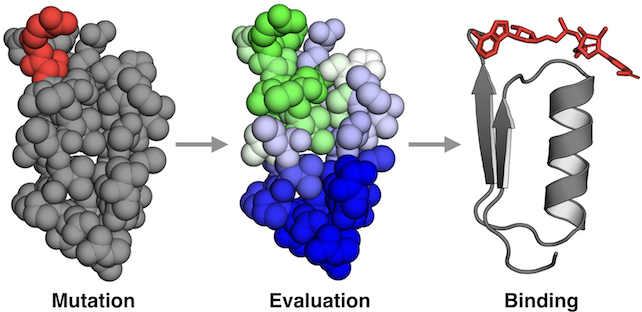Prediction and re-engineering of the cofactor specificity of Rossmann-fold proteins
Project description
Prediction and re-engineering of the cofactor specificity of Rossmann-fold proteins
Installation
pip install rossmann-toolbox
Alternatively, to get the most recent changes, install directly from the repository:
pip install git+https://github.com/labstructbioinf/rossmann-toolbox.git
For some of the features additional dependencies are required:
| Package | Sequence variant | Structure variant |
|---|---|---|
| FoldX4 | - | required |
| DSSP3 | - | required |
| HH-suite3 | optional | optional |
Getting started
Sequence-based approach
The input is a full-length sequence. The algorithm first detects Rossmann cores (i.e. the β-α-β motifs that interact with the cofactor) in the sequence and later evaluates their cofactor specificity:
from rossmann_toolbox import RossmannToolbox
rtb = RossmannToolbox(use_gpu=True)
data = {'3m6i_A': 'MASSASKTNIGVFTNPQHDLWISEASPSLESVQKGEELKEGEVTVAVRSTGICGSDVHFWKHGCIGPMIVECDHVLGHESAGEVIAVHPSVKSIKVGDRVAIEPQVICNACEPCLTGRYNGCERVDFLSTPPVPGLLRRYVNHPAVWCHKIGNMSYENGAMLEPLSVALAGLQRAGVRLGDPVLICGAGPIGLITMLCAKAAGACPLVITDIDEGRLKFAKEICPEVVTHKVERLSAEESAKKIVESFGGIEPAVALECTGVESSIAAAIWAVKFGGKVFVIGVGKNEIQIPFMRASVREVDLQFQYRYCNTWPRAIRLVENGLVDLTRLVTHRFPLEDALKAFETASDPKTGAIKVQIQSLE'}
preds = rtb.predict(data, mode='seq')
preds = {'3m6i_A': {'FAD': 0.0008955444,
'NAD': 0.998446,
'NADP': 0.00015508455,
'SAM': 0.0002544397, ...}}
Structure-based approach
The input is a protein structure. Preparation steps are the same as above, but additionally, structural features are calculated via FOLDX software, and secondary structure features via DSSP
# required binaries
PATH_FOLDX = ...
PATH_HHPRED = ...
PATH_DSSP = ...
path_to_structures = ... # path to pdb files
chains_to_use = ... # chains to load from `path_to_structures`
rtb = RossmannToolbox(use_gpu=False, foldx_loc = PATH_FOLDX,
hhsearch_loc = PATH_HHPRED,
dssp_loc = PATH_DSSP)
preds = rtb.predict_structure(path_to_structures, chains_to_use, mode='seq', core_detect_mode='dl')
preds = [{'NAD': 0.99977881,
'NADP': 0.0018195,
'SAM': 0.00341983,
'FAD': 3.62e-05,
'seq': 'AGVRLGDPVLICGAGPIGLITMLCAKAAGACPLVITDIDEGRL',
'NAD_std': 0.0003879,
'NADP_std': 0.00213571,
'SAM_std': 0.00411747,
'FAD_std': 3.95e-05}]
What next?
To learn about other features of the rossmann-toolbox, such as visualization of the results, please refer to the notebook examples/example_minimal.ipynb.
Contact
If you have any questions, problems or suggestions, please contact us. The rossmann-toolbox was developed by Kamil Kaminski, Jan Ludwiczak, Maciej Jasinski, Adriana Bukala,
Rafal Madaj, Krzysztof Szczepaniak, and Stanislaw Dunin-Horkawicz.
This work was supported by the First TEAM program of the Foundation for Polish Science co-financed by the European Union under the European Regional Development Fund.
Project details
Release history Release notifications | RSS feed
Download files
Download the file for your platform. If you're not sure which to choose, learn more about installing packages.
Source Distribution
Built Distribution
File details
Details for the file rossmann-toolbox-0.1.0.tar.gz.
File metadata
- Download URL: rossmann-toolbox-0.1.0.tar.gz
- Upload date:
- Size: 11.1 MB
- Tags: Source
- Uploaded using Trusted Publishing? No
- Uploaded via: poetry/1.1.6 CPython/3.6.9 Linux/4.15.0-121-generic
File hashes
| Algorithm | Hash digest | |
|---|---|---|
| SHA256 |
e473e39ef8dfda8e4d818b34cbdf15392433411786bbd03e0f0c7873b0a3e381
|
|
| MD5 |
3806585578df31d1323595f2b0ddc2d2
|
|
| BLAKE2b-256 |
dc030f1456add821b3381a3996187a25e53b6cf84db8eab7cfb97227fd6675af
|
File details
Details for the file rossmann_toolbox-0.1.0-py3-none-any.whl.
File metadata
- Download URL: rossmann_toolbox-0.1.0-py3-none-any.whl
- Upload date:
- Size: 11.1 MB
- Tags: Python 3
- Uploaded using Trusted Publishing? No
- Uploaded via: poetry/1.1.6 CPython/3.6.9 Linux/4.15.0-121-generic
File hashes
| Algorithm | Hash digest | |
|---|---|---|
| SHA256 |
a9d0cb5e75ea2a965416ae0c0ac2f0e447be7c511d330cf12bd1911d79253211
|
|
| MD5 |
27cb922e5b915bf9133887159c5c4335
|
|
| BLAKE2b-256 |
74fe96d51726b6a553cb23cdd05b83093a917514cae7398054204a45e4654456
|













